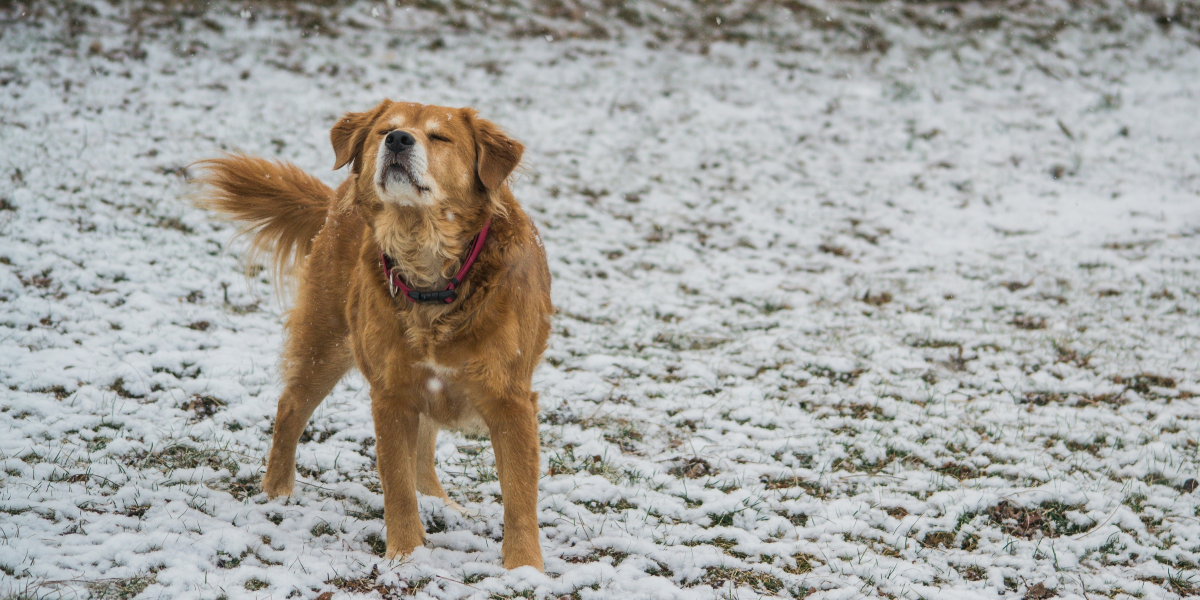Physical Adaptations for Cold Environments
Dogs adapted to colder climates often have specialized physical traits that help them manage the cold effectively.
Thick, Double-Coated Fur
Breeds like the Siberian Husky, Alaskan Malamute, and Samoyed have double-layered fur that traps heat close to the body. The dense undercoat provides insulation, while the outer coat repels moisture and protects against the wind. This coat keeps them warm in freezing temperatures but can cause overheating in warmer, humid climates.
Increased Body Fat
Many cold-weather breeds have higher body fat, which acts as insulation against the cold and stores energy for harsh conditions. However, this fat layer can hinder a dog’s ability to cool down in warmer climates, increasing its risk of overheating.
Body Shape for Heat Retention
Breeds from cold climates typically have a compact, stocky build, which minimizes the surface area exposed to cold air, allowing them to retain body heat. This physical trait is less effective in hot climates, where breeds with longer, leaner bodies are better equipped to dissipate heat.
The Role of Breed Origins and Evolution
The origins of many cold-adapted dog breeds play a key role in their ability to handle low temperatures.
Arctic Breeds
Breeds like the Siberian Husky and Alaskan Malamute evolved in frigid conditions, where they were bred for endurance and physical work. These dogs perform well in cold, requiring little care in winter, but their energy levels and thick coats can be challenging in warmer environments.
Mountain Breeds
Mountain dogs, including Saint Bernards and Bernese Mountain Dogs, have evolved to thrive in cold, high-altitude environments. Their heavy coats are designed to withstand snow and ice but can become uncomfortable and prone to overheating in warmer climates.
Behavioral Adaptations to Temperature
Cold-adapted dogs exhibit specific behaviors that help them survive in cooler conditions but can make it harder for them to tolerate hot climates.
Reduced Heat Tolerance
Cold-weather breeds have a lower tolerance to heat and may become lethargic or irritable in warm temperatures. Their ability to retain heat can quickly lead to overheating, especially in humid climates.
High Energy and Activity Needs
These breeds are naturally high-energy and require frequent exercise, which can be risky in hot weather. Physical activity in the heat increases their risk of dehydration and heat exhaustion, necessitating careful scheduling of exercise times in hot climates.
Health and Survival Risks in Warmer Climates
Cold-climate dogs face several health risks when exposed to warm or tropical environments.
Skin and Coat Issues
The thick fur of cold-weather dogs can lead to skin infections or hot spots in humid conditions. Grooming is essential to manage their coats, but some dogs still experience discomfort due to trapped moisture.
Risk of Heat Stroke
Heat stroke is a significant concern for cold-adapted breeds in warmer climates. Their thick coats make it difficult to regulate their body temperature, leading to dangerous overheating, especially in high temperatures.
Dehydration and Hydration Needs
Cold-weather breeds are less inclined to drink water regularly, making them more susceptible to dehydration in hot climates. Ensuring adequate hydration, especially after exercise, is crucial to their health in warmer environments.
Genetic Traits for Cold-Weather Survival
Cold-adapted dog breeds have developed specific genetic traits over generations that allow them to survive and thrive in harsh, cold climates. These traits are deeply ingrained and have evolved to help them endure freezing temperatures and physically demanding environments.
Thick Undercoats for Insulation
The dense undercoats of cold-weather breeds help trap warmth, which is vital for surviving freezing temperatures. However, these undercoats can hinder a dog’s ability to cool down in warmer weather, necessitating regular grooming and care.
Metabolic Rates and Energy Conservation
Cold-climate dogs have slower metabolic rates, designed to conserve energy during cold months. This slower metabolism can make it harder for them to regulate temperature in warmer environments, further exacerbating the risk of overheating.
Cold-adapted breeds are naturally suited for colder climates, but their specialized traits can make life challenging in tropical environments. Proper care and attention to temperature regulation are essential for keeping these breeds healthy in warmer climates.
Published by: Holy Minoza














